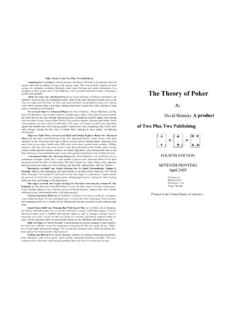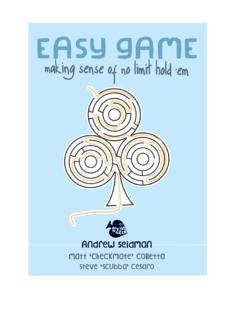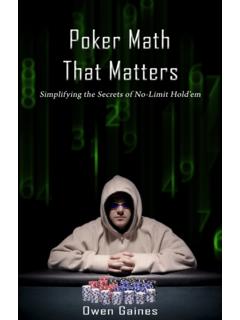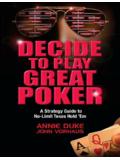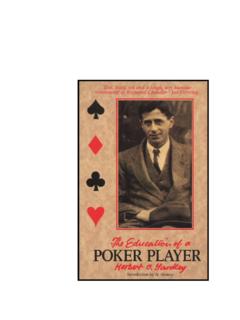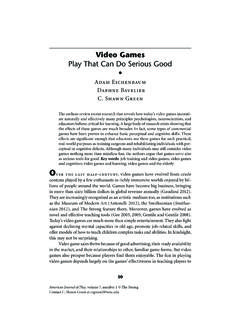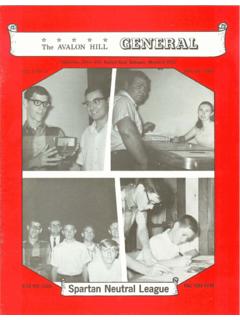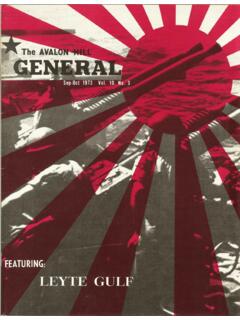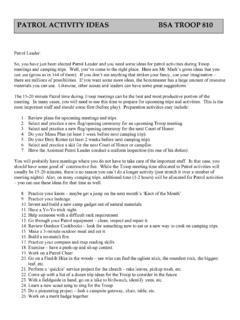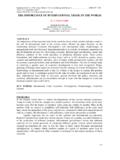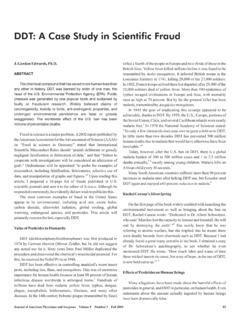Transcription of Easy Game Vol. 1 - gamblingsystem.biz
1 easy Game Making Sense of No Limit Hold em Vol. 1 easy Game Vol. 1 is 2009 Andrew Seidman, except HU Play for Beginners, which is 2009 Matt Colletta 2 Table of Contents A Game of Chapter One: The Reasons for Chapter Two: Preflop Hand Ranges and Postflop Chapter Three: Aggression and the Chapter Four: Bet Sizing and Thin Chapter Five: Player Identification and Basic Chapter Six: Isolation Chapter Seven: Table Chapter Eight: Creative Preflop Raise Chapter Nine: Value Streets and Pot Chapter Ten: Showdown Chapter Eleven: Monotone Boards and Chapter Twelve: A Brief Understanding of G Chapter Thirteen: Full Ring vs. 6 max and Positional Chapter Fourteen: An Introduction to 3 Bet Introduction to HU Chapter Fifteen: HU Play for The Basics: 3 Introduction There are a lot of books about poker, particularly about the game that has become a modern phenomenon: No-Limit Texas Hold em.
2 The legend Doyle Brunson describes the game as the Cadillac of poker because the nature of the game allows for so much creativity. The ability to bet any amount at any time makes the game both attractive and dangerous at once unlike Limit games , where the wager is fixed and only a few bets can go in each round, in No-Limit all it takes is one big mistake and suddenly you re out of a stack of chips. The key word to focus on is mistake. David Sklansky s The Theory of Poker spells out the Fundamental Theorem of Poker. It says, essentially, that whoever makes the most (and biggest) mistakes loses, and conversely whoever makes the least (and smallest) mistakes wins. It s incredible how many poker players even good players, and some great ones ignore this concept and constantly make suboptimal plays. We ll talk about this in more detail later. To understand this book, you ll need to recognize some terminology.
3 While we ll discuss the important concepts in detail, we can define some simple terms first: C-betting means continuation betting, or making a bet after being a preflop aggressor. NL refers to No-Limit. 3-betting refers to making a third raise (preflop, the blinds are considered the first bet; thus, a second bet is called a raise, and the third bet would be called a 3-bet. 4-betting, 5-betting, and so on continue logically). OOP means out of position , while IP refers to being in position. c/f means check-fold (to check with the intention of folding to a bet). c/r means check-raise (to check with the intention of raising a bet) c/c means check-call (to check with the intention of calling a bet) To Flat means to call a bet or raise (as opposed to reraising). To Float means to call a flop bet with the intention of taking the pot away on a later street. A Wet Board means a strongly coordinated board in which cards have some combination of highness, suitedness, and connectedness.
4 A Dry Board means an uncoordinated board in which cards lack highness, suitedness, and/or connectedness. Implied Odds refers to our ability to win money once we ve hit a hand (for example, 22 has great implied odds with 200bb stacks, as it can win a lot if it flops a set of 2 s). Reverse Implied Odds refers to our ability to lose money once we ve hit a hand (for example, KQ has high reverse implied odds when it flops a pair 200bb deep, but low reverse implied odds when it flops a pair 30bb deep). 4 This book will explain shorthanded No-Limit Hold em to you in two steps first, the basic knowledge you will need to be a competent poker player and thinker. Mastery of this knowledge alone should be enough to earn you $100+ per hour in online or live games . Second, we will delve into advanced concepts that are the keystones to success at higher stakes. Do not skip straight to the second section. In the modern age of poker instructional videos and websites, many small stakes players watch their high stakes heroes using advanced moves and playing in unorthodox styles.
5 The small stakes players then try to mimic these plays without understanding the vital framework of knowledge that makes these moves profitable. In short, if you skip straight to the second section, it will probably cause you to lose money. Now that we re ready to get underway, just remember: getting good at poker is about learning and not winning. Many players emphasize winning only, and their game stagnates. They re quickly passed by players who are focused on learning and view winning as a nice side benefit. And indeed it is. Learning will occur one step at a time. Each chapter will outline an important poker concept try to understand it before you move on to the next. They re building blocks. Give them your time and focus you ll be a better player in no time. 5 THE BASICS A Game of Information At the very beginning of our poker experience, we have no idea what is happening around us. We don t perceive information well.
6 In fact, we re usually limited to two very basic pieces of information the cards in our hand and the cards on the board. Other pieces of information are completely lost to us things like our opponents likely hand ranges, game-flow, the effects of image, player types and tendencies, etc. The point is this: the more information a player gathers and uses, the better he is at poker. The less information a player gathers and uses, the worse he is. In the following chapters, we ll talk about the ways to both gather and use information what to look for, what it means, and what to do in response. The purpose of the first section of this book is to outline basic game strategies and theories that should allow you to deal comfortably with weaker players and will prepare you for playing against tougher, thinking opponents. Each concept builds upon the one before it, so Chapter One is the most important chapter in this section.
7 Welcome to the world of aggressive, winning poker. 6 Chapter One: The Reasons for Betting I hope you re ready for this, because we re about to define our entire poker existence. It s a simple word: why? Poor players never question their decisions. Average players start to ask themselves why but have wildly insufficient answers. When I m coaching students, this is one of the first things I see that needs fixing. A student makes a bet, and I ask him why he s betting. Common answers include: I m pretty sure I have the best hand, I m gaining information to see where I m at, or I m betting to protect my hand. The problem is that those aren t reasons for betting. Things like information or protection may be side effects of betting, but they re not reasons. So what are the reasons for betting? There are only three. In order to justify a bet or raise at any time, we ll need to rely on these three (and only these three) reasons.
8 We ll deal with the first two first: 1) Value. This is defined as betting to get called (or raised) by a worse hand. Betting just because you probably have the best hand is NOT sufficient to bet for value. 2) Bluff. This is defined as betting to get a better hand to fold. Betting just because you can t win any other way is NOT sufficient to bet as a bluff. These two are pretty simple. They rely on mistakes our opponents make either calling too much or folding too much. It s human nature to call too much. We re curious beings and we want to see what the other guy holds, what the turn card will be, whether or not we hit our flush on the river. People are more inclined to make the mistake of calling too much than the mistake of folding too much. Therefore, reason #1 for betting will dominate our bets. Value-betting is, was, and always will be the best way to make money. At a micro-stakes game, let s say $25nl, nearly everyone at the table will call absurdly often, so reason #2 for betting becomes more or less useless.
9 At $5000nl, nearly everyone at the table will be good enough to avoid paying off your value bets too often, and thus reason #1 decreases in utility and reason #2 becomes more important. In general, though, even regulars at high stakes games are more likely to make bad calls than bad folds as a general rule. So what about c-betting? Let s say we raised KQo on the button, and the big blind (a loose, passive player who won t fold ANY pair on the flop) calls us. The flop comes down A75r. He checks to us. This is a very standard bet. Why? Hmm. We can t get called by any worse hands (QJ isn t coming along for the ride). Even a hand like 86 is roughly a coin-flip against us in terms of equity. So we can t bet for value. Sticking with our assumption that he s not folding any pairs, we can t bet as a bluff either as we have the best non-pair hand possible. Yet we still bet. Why? 3) Capitalization of Dead Money.
10 This is defined as making the opponent fold, whether his hand is better or worse, and collecting the money in the pot. This is obviously a fair amount trickier than reasons #1 or #2. What makes this mysterious third reason work? 7 a) We make him fold his equity share in the pot. On the A75 flop where we hold KQ, if the opponent holds JT, his six-outer still has a strong amount of equity to draw out. Making him fold that equity share is good. (One exception would be if the villain is likely to bluff AND our hand is strong enough to call a potential bluff. On this A75 board, if we check behind on the flop, villain is likely to check all of his air-type hands and bet all of his pair-or-better hands. Thus, villain is unlikely to bluff and our hand isn t strong enough to be a bluff catcher, so we can t check behind. More on this concept later in the section titled Showdown Theory. ) b) The dead money more than compensates for the times when we re called and lose.
